
The foot of the El Farell mountain is an area of geological faults and folds which favour the formation of hot springs
El peu de la muntanya del Farell és una zona de plegaments i fractures geològiques que afavoreixen l’aflorament de les aigües termals
Caldes de Montbui is a town situated in the middle of the area called El Vallès Oriental, only 30 kilometres from Barcelona, which from distant times has revolved around the thermal waters.
It has the privelege of being the first town of thermal baths of Catalonia and posseses the best conserved Roman baths in the Península Ibérica, declared as a Cultural Heritage Site of National Interest. This appeal is complemented by other attractions which make the spa an important cultural, sporting, nature and tourist resort.
Its good geographical situation, a mild climate and waters that gush out at high temperatures, one of the hottest in Europe, have shaped the history and life of this town of more than 17.000 inhabitants, that has its heart in the place of the Lion Fountain.
If we penetrate by foot into the symbolic streets of the core of the old town, we can follow the historical and thermal itinerary which includes the ancient roman baths, the symbolic Font del Lleó (Lion Spring) and the communal laundry which is supplied with hot spring wáter.
Caldes de Montbui és una vila que es troba al bell mig del Vallès, a només 30 quilòmetres de Barcelona, i gira des de temps remots a l'entorn de l'aigua termal.
Té el privilegi de ser la primera vila termal de Catalunya i de posseir les termes romanes més ben conservades de la Península, declarades com a Bé Cultural d'Interès Nacional. Aquest atractiu es completa amb altres al·licients que fan de la vila termal un centre turístic, cultural, esportiu i natural.
El seu bon emplaçament geogràfic, un clima suau i benigne i unes aigües termals que brollen a una de les temperaturas més elevades d'Europa, han configurat la vida d'aquesta població de més de 17.000 habitants, que té el seu cor a la plaça de la Font del Lleó.
Si ens endinsem a través dels emblemàtics carrers del nucli antic, podem descobrir en una passejada l'històric itinerari termal: les antigues Termes Romanes, la simbòlica Font del Lleó i els safareigs d'aigua termal, avui dia encara en funcionament.
HOT SPRINGS AIGÜES TERMALS
Called "Hot Springs' mineral waters that come to land at a higher temperature (more than 5°C) to the surrounding temperature (surface).
These waters come from underground layers of earth that are at higher temperatures, which are rich in mineral components and allow their use in therapy (in the form of baths, inhalations, irrigations), or a heating system.
It is usually found along fault lines, as along the plane of the fault, can be introduced into groundwater that is heated to a certain depth and then ascend in the form of hot water or steam (which can condense to reach the surface, creating a geyser).
Anomenem “Aigües Termals”, a les aigües minerals que surten del sòl a una temperatura superior (en més de 5°C) a la temperatura ambient que la rodeja (superficial).
Aquestes aigües procedeixen de capes subterrànies de la Terra que es troben a major temperatura, les quals són riques en diferents components minerals i permeten la seva utilització en terapèutica (en forma de banys, inhalacions, irrigacions), i com a sistema de calefacció.
En general es troben al llarg de línies de falles, ja que al llarg del pla de la falla, es poden introduir les aigües subterrànies que s'escalfen en arribar a certa profunditat i pugen després en forma d'aigua calenta o de vapor (que pot condensar en arribar a la superfície, formant un guèiser).
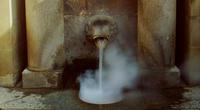
Origin of thermal waters of Caldes de Montbui:
The upwelling of thermal water from Caldes de Montbui emanating from the granite, and the upwelling temperature is highest in Spain. (these waters, most likely owed its considerable upwelling temperature in a geothermal system at depth and the geothermal gradient).
This upwelling can not be observed directly, because the water is channeled by a very old gallery, which is not passable without special equipment due to water vapor. For this reason, this Earthcache focuses on the observation of thermal water that flows from the Lion Spring (Font del Lleó).
From a geological point of view, this upwelling is located in the northern edge of the Valles region, formed by a fault in this area, connects the Miocene detrital (fill in the south of the Vallès depression), with granite, towards the north.
This upwelling is a classic case of juvenile origin of water, ie that the hot spring waters from the release of water from the granitic magma, as it ascended to the surface.
Origen de les aigües termals de Caldes de Montbui:
La surgència d'aigua termal de Caldes de Montbui, emana del granit, i constitueix la surgència de temperatura més elevada d'Espanya. (aquestes aigües, molt probablement, deguin la seva considerable temperatura de surgència a un sistema geotèrmic en profunditat i no al gradient geotèrmic).
Aquesta surgència no és pot observar directament, ja que l'aigua està canalitzada per una galeria molt antiga, la qual no és transitable sense equip especial a causa del vapor d'aigua. Per aquest motiu, aquest Earthcache es centra en l’observació de l’aigua termal que brolla de la Font del Lleó.
Des del punt de vista geològic, aquesta surgència està situada al límit nord de la regió del Vallès, constituït per una falla que, en aquesta zona, posa en contacte el Miocè detrític (que omple la depressió del Vallès pel sud), amb el granit cap al nord.
Aquesta surgència constitueix un exemple clàssic de l'origen juvenil de les aigües, o sigui, que les aigües surgents provenen de l'alliberament de l'aigua del magma granític, conforme aquest ascendeix cap a la superfície.
Additional Geological Information Graphics: Informació Geològica Gràfica complementària:
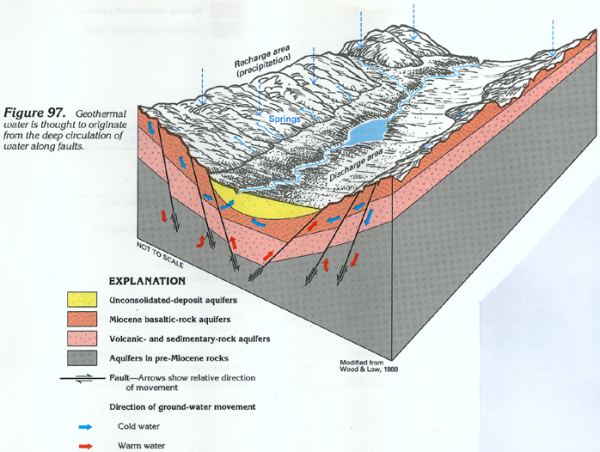
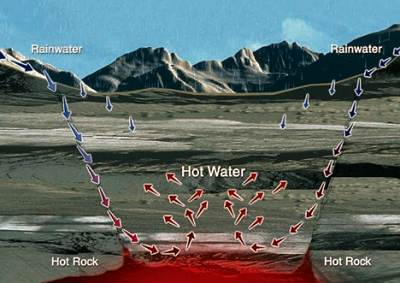
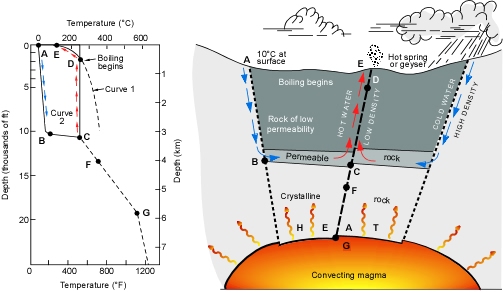
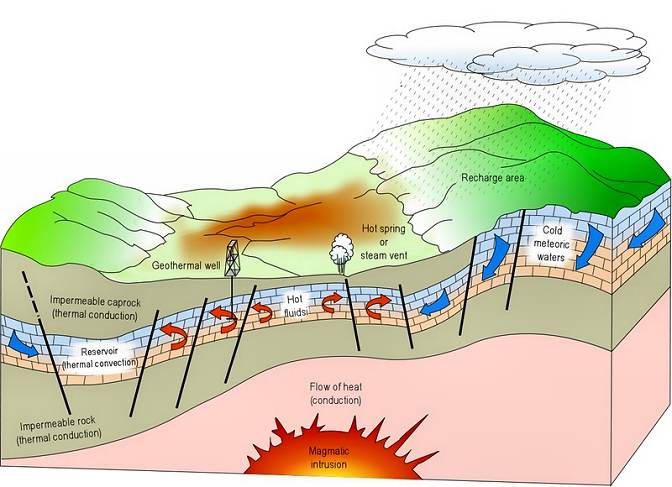
Classification according to their Temperature:
- Cold water (less than 20°C)
- Water Hypothermal (20-35°C)
- Water Mesothermal (35-45°C)
- Water Hyperthermal (45-100°C)
- Water Superthermal (100-150°C)
Classification according to their Mineral composition:
- Ferruginous Water: present fundamentally iron. Especially effective for treating liver diseases and deficiencies states.
- Chlorinated Water: chlorine present. Stimulate digestive secretions, among others.
- Sulphurous and Sulphurated Waters: with sulfur. Much used in the field of medical hydrology.
- Sulphated Water: a part of sulfur may include sodium, calcium, magnesium and chlorine in the composition. Very used.
- Bicarbonated Water: with bicarbonate. They can be sodium, calcium, mixed, chloride or sulfate. Used in states of gastric acidity.
A hot spring is a fountain that is produced by the emergence of geothermal groundwater in the earth crust. There are hot springs all over the world on every continent and even under the oceans and seas ...
Classificació segons les seves temperatures:
- Aigües Fredes (menys de 20°C)
- Aigües Hipotermals (20-35°C)
- Aigües Mesotermals (35-45°C)
- Aigües Hipertermals (45-100°C)
- Aigües Supertermals (100-150°C)
Classificació segons la seva Composició mineral:
- Aigües Ferruginoses: presenten fonamentalment ferro. Especialment eficaç per pal.liar estats carencials i malalties hepàtiques.
- Aigües Clorades: presenten clor. Estimulen les secrecions digestives, entre altres.
- Aigües Sulfurades i Sulfuroses: amb sofre. Molt utilitzades en el camp de la hidrologia mèdica.
- Aigües Sulfatades: a part de sofre poden incloure sodi, calci, magnesi o clor en la composició. Molt utilitzades.
- Aigües Bicarbonatades: amb bicarbonat. Poden ser sòdiques, càlciques, mixtes, clorurades o sulfatades. S'utilitzen en estats d'acidesa gàstrica.
Una Font Termal és una font que es produeix per l'emergència d'aigües subterrànies geotermals de l'escorça terrestre. Hi ha fonts termals a tot el món, en tots els continents i fins i tot sota els oceans i mars ...
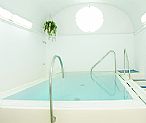
The thermal waters of Caldas de Montbui are mineromedicinals because they contain dissolved minerals that provide therapeutic properties. Therapeutic applications of thermal water from Caldes de Montbui: Rheumatism (arthritis and arthrosis), Post-trauma recovery, Respiratory diseases, Psychosomatic diseases (stress and anxiety), Obesity, Skin Care, Relaxation, Beauty treatments, ...
Les aigües termals de Caldes de Montbui són mineromedicinals ja que contenen substàncies minerals dissoltes que els proporcionen propietats terapèutiques. Aplicacions terapèutiques de l'aigua termal de Caldes de Montbui: Reumatismes (artritis i artrosis), Recuperació post-traumatismes, Vies respiratòries, Malalties psicosomàtiques (estrés i ansietat), Obesitat, Cura de la pell, Relaxació, Tractaments de bellesa, ...



The FONT DEL LLEÓ (LION SPRING) a natural spring La FONT DEL LLEÓ un brollador natural

Is the most well-known hot spring in Caldes de Montbui. It is situated in the square which bears its name, in the middle of the old town centre (initial coordinates). The Font del Lleó was built in 1581 and was renovated in 1822. In spite of the reforms, the gargoyle and the base wall have been preserved over the years.
The spring that we can admire today dates from 1927, the year in which it was restored and improved by Manuel Raspall, who gave a "noucentist" character to the present monument, with the lion which gives the spring its present name, and has become the symbol of the town. The water is then redirected to the “safareigs públics” (communal washing houses), constructed in the 19th century and still in use to this very day. The villagers still use water for various household chores such as cooking the vegetables, clean ...
És el brollador d'aigua termal més característic de la població. Aquesta font termal, es troba situada a la plaça de la Font del Lleó (coordenades inicials). La Font del Lleó es va construir el 1581 i va ser renovada el 1822. Tot i les reformes, la gàrgola i la paret del fons s'han conservat al llarg del temps.
La font, tal i com la podem admirar avui, data del 1927, any en què fou restaurada i afavorida per Manuel Raspall, que va projectar l'actual monument d'aire noucentista, amb el característic lleó que ha esdevingut símbol de la vila. L’aigua termal que surt va a parar als safareigs públics, construïts al segle XIX i amb la singularitat que avui dia encara estan en funcionament. Els vilatans utilitzen encara avui dia l'aigua per diverses tasques domèstiques com cuinar els llegums, netejar...
LA PORTALERA communal washing house Safareig públic de LA PORTALERA
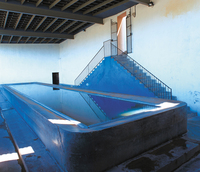
Laundry hot spring that changed its location in the late 19th century, as it was originally located on the street of Santa Susanna and are currently on Wall Street (carrer de la Muralla). The water of the pond comes from the Lion Spring (Font del Lleó) and even today is emptied and cleaned daily and filled again during the night. Although use and access is free in the mornings from Monday to Sunday.
Safareig d'aigua termal que va canviar el seu emplaçament a finals del segle XIX, ja que inicialment estava ubicat al carrer de Santa Susanna i actualment el trobem al carrer de la Muralla. L'aigua del safareig prové de la Font del Lleó i encara avui en dia es buida i es neteja diàriament i s'omple de nou durant la nit. Encara s'utilitza i l'accés és lliure els matins de dilluns a diumenge.
LA CANALETA communal washing house Safareig públic de LA CANALETA

Located in General Padrós Street at the end of the Santa Rosa Street. To access the laundry room down stairs where they have also found the source of Canaleta (Font de la Canaleta).
The laundry was built in 1929 under the direction Manuel Raspall. His good condition due to a workshop that the school was restored in 2005 and also is equipped with informative panels produced by the museum project in the Thermal Conversion of thermal pools in the Interpretation centers mineral water.
He is currently a facility for public use and open access in the mornings from Monday to Saturday.
Està situat al carrer General Padrós, al final del carrer Santa Rosa. Per accedir al safareig s'han de baixar unes escales on també es troba la Font de la Canaleta.
El safareig es va construir l'any 1929 sota la direcció Manuel Raspall. El seu bon estat de conservació es deu a un taller-escola que el va restaurar l'any 2005 i, a més, està dotat de plafons informatius elaborats pel museu Thermalia dins el projecte de conversió dels safareigs termals en centres d'intepretació de l'aigua termal. Actualment és un equipament d'ús públic i d'accés lliure els matins de dilluns a dissabte.
Ancient ROMAN BATHS Antigues TERMES ROMANES
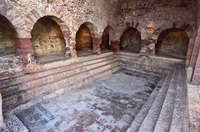
The town of Caldas was in Roman times, a spa founded on the hot springs that gush. The primary function of this group was cured numerous patients who came to the place from different points of Roman Hispania.
The room you see is only part of the huge bath complex that existed in Roman times which stretched the Old Hospital (now Thermalia), the spa hotels of Rius and Broquetas, and the present square of the Lion Spirng (Font del Lleó). Up to now, fifteen areas of the Roman bath complex have been located, although it is possible that many more remain to be found. Currently, we can see, on one hand, a rectangular pool, central hot spring, and another two more in the form of semicircular Exedra front that make individual bathrooms.
La vila de Caldes fou, en època romana, una estació termal fundada sobre les deus d'aigua calenta que hi brollen. La funció primordial d'aquest conjunt era curar els nombrosos malalts que arribaven a l'indret des de diferents punts de la Hispània romana.
La sala que es veu és només una part del gran conjunt termal que hi havia en temps dels romans que s'estenia per l'Antic Hospital, gran part dels balnearis Rius i Broquetas i l'actual plaça de la Font del Lleó. Fins al moment, s'han localitzat quinze àmbits del conjunt termal romà. Actualment, hi podem veure, per una banda, una piscina rectangular, central, d'aigua termal i, per una altra, dues més en forma d'exedres semicirculars frontals que fan de banys individuals.



To validate this EarthCache: Per validar aquest EarthCache:
1] By registering the cache, you can take a picture with your GPS in these coordinates, and upload it with your registration. (optional)
Al registrar el catxé, us podeu fer una fotografia amb el vostre GPS, en aquestes coordenades, i penjar-la amb el vostre registre. (opcional)
2] To answer the following questions: Contestar les següents preguntes:
- What is the temperature of the water that flows from the Lion Spring (Font del Lleó)? If you have a thermometer, personally take the temperature of the water. It will be interesting to see the variation in temperature between geocachers and throughout the year.
- We expect a large variability in the temperature of thermal water, throughout the year? Reasons it.
- The thermal waters of the Lion Spring (Font del Lleó), has a strong disagreeable odor? The water is transparent or has color?
- Based on temperature and mineral composition, which is the type of thermal water springs from the Lion Spring (Font del Lleó)?
(ex: supertermal ferruginous)
- Almost any country can have hot springs within its limits. Many sites / towns in the world have names related to this geological feature, such as: Hot Springs - Arkansas (United States), Caldas de Luna - Castilla y Leon (Spain), or Caldes de Montbui! Name any other town in the world, in whose name meets this characteristic.
- Quina és la temperatura de l'aigua que brolla de la Font del Lleó? Si teniu un termòmetre preneu personalment la temperatura de l'aigua. Serà interessant veure la variació de les temperatures, entre geocachers, i al llarg de l’any.
- Es d’esperar una gran variabilitat, en la temperatura de l’aigua termal, al llarg de l’any? Raona-ho.
- L’aigua termal que brolla de la Font del Lleó, te una forta olor desagradable? Es transparent, o presenta coloració?
- Atenent a la temperatura i a la seva composició mineral, quin tipus d’aigua termal brolla de la Font del Lleó? (ex: supertermal ferruginosa)
- Pràcticament qualsevol país pot presentar dins dels seus límits aigües termals. Molts llocs/municipis en el món tenen noms relacionats amb aquesta característica geològica, com per exemple: Hot Springs - Arkansas (als Estats Units), Caldas de Luna - Castilla y León (a Espanya), o Caldes de Montbui!! Anomena alguna altra població, d’arreu del món, que el seu nom compleixi aquesta característica.



You must send the answers (in Catalan, Spanish or English). You can log it without waiting to receive my validating response.
Heu d'enviar les respostes (en Català, Castellà o Anglès). No cal esperar la meva resposta per fer el registre online.
I hope you enjoy this beautiful place. Espero que gaudiu d'aquest paratge.
Remember: If you can, bring a thermometer!
Recorda: Si podeu, porteu un termòmetre!

